はじめまして、ものさす塾生の吉田です。
前職では、東京近郊の住宅、マンション、店舗、建築の設計、施工を一括で行う会社で働いていました。その会社では、木材を使ってオーダー家具も制作していたため、木材が常に身近にあり、僕自身少しずつ、木というものに興味を抱くようになっていました。
神山は、木材である杉の木がたくさんそびえています。戦後すぐの頃、国の政策でたくさんの人が林業に携わりましたが、文明の発達と共に林業自体が衰退し、人がいなくなった山にたくさんの杉の木だけが残ったそうです。
その後、何十年と月日が経過し、人の手が入らぬまま間伐されずに生い茂った杉の木が、自然の循環を壊しつつある現状を知りました。
そのことに向き合って、新しいコトやモノを生み出していこうと立ち上がった人たちがいます。そして、その人たちとの出会いは、僕自身を見つめなすきっかけになりました。
建築業界に携わってきて、木材に何気なく触れてきましたが、神山にものさす塾生として訪れ、地域の人と交わった中で、人が暮らすために必要な木とはどのような背景で育ち、活用されていっているのか?
今回は、そんな木に携わる人達を通して体験したこと、感じたことを書こうと思います。
今回の神山ものさす塾レポーター
-

-
吉田 大輔
前職は建築関係。家、木の素材、質感が好み。
神山ものさす塾生として、ここに移住して少ししてから、徳島市と神山をつなぐ国道438号線沿いに建つ「木の町 かみやま」の看板が目に止まった。ここは、木の町なの?そんな素朴な疑問のから、真相を確かめるため、会いたい人に会いに行く旅のはじまり、はじまり。
木を切る人
「この杉の木をみんな宝の山に」
金泉製材所 金泉 裕幸(かねいずみ ひろゆき)さん
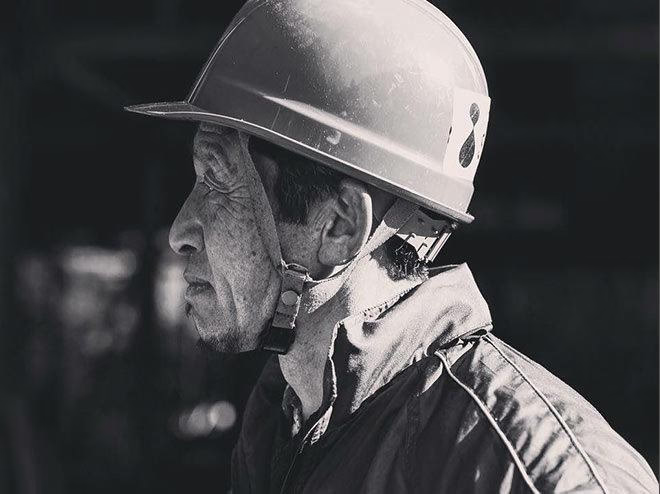
神山町上分金泉地区で代々受け継がれている製材所を営んでいる、金泉さん。
金泉さんと知り合ったのは、ものさす塾生の佐藤君に誘われて、林業体験ツアーに参加したのがきっかけだった。
林業と言えば、『ウッジョブ』という映画のイメージが、強く頭の中に残っている。
山に生きる木こりの過酷さの中に、人間味あふれる情の深さや、何代も先の子孫のことまで考える生き方がとても印象に残っている。とても好きな映画だったが、果たして実際の林業とはどんなものなのだろうか。
前職で携わっていた建築業では、すでに加工が終わっている建築用の製材にしか、ほとんど触れる機会がなかった。
製材についての動画。丸太から製材を挽くときに使う特殊な機械の様子をみることができる。一本の丸太をそのまま縦に切っていくのを見ていて、圧巻だった。
人の手によって、一本の木から商品としての製材にどんな風になっていくのか?製材になる前ってどんなだろ?
そんな自分の好奇心に従って体感してみようと思ったのだ。
普段入ることないであろう山奥に、軽トラックの荷台に揺られて現地に到着。
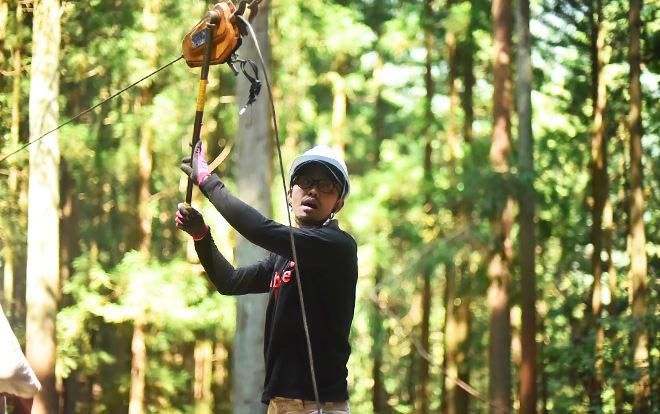
まずは切る木を決めて、ワイヤーで切る木と倒れる方向にある木を結び、ワイヤーを巻き取るためのウィンチでピンと引っ張る。倒れる方向を誘導するためだそうだ。
そこからいよいよ、木を切る作業だ。
倒す前に倒れる方向側にチェンソーで受け口(切り込み)を入れておく。
受けを入れた逆側から追い口で切り、倒していく。
倒れ切った時、真ん中のツルの部分が残っている状態が一番理想的な断面だそうだ。
受け口を入れすぎると、フレキシブルになりすぎて倒れる方向が分からない状態になってしまう。
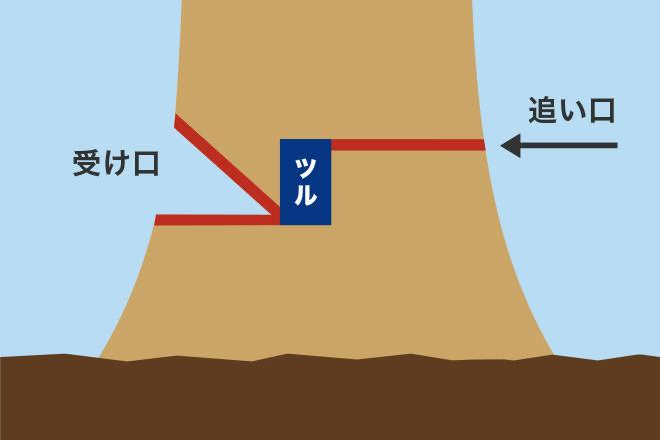
ツルの部分を残し、受け口側に倒れるようにすることで、ワイヤーの力と受け口、追い口のバランスで、倒れる方向を促すことができるわけだ。
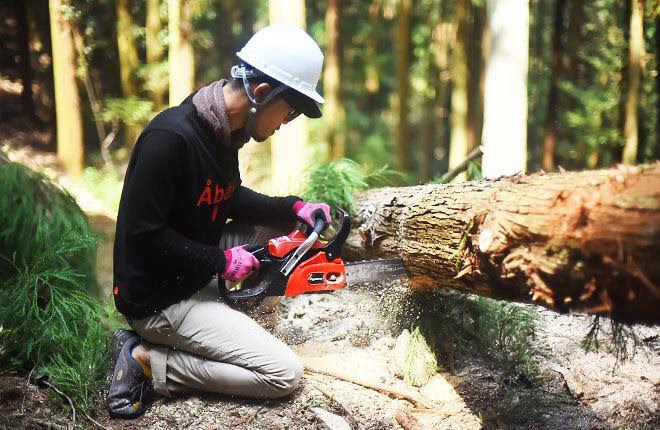
倒した後は細かい枝をとり払い、一本の木を分割し運びやすしていく。
太い大きなスギの木が、切り倒される瞬間は本当に圧巻で気持ちが良かった。
こんなに大きな木が目の前でバッターンと倒れるさまは迫力が違う。
この時の切り倒した瞬間の様子。気持ちがいい!!
一歩間違えれば、大事故につながりかねない危険な作業でもある。
次回はチェンソーで自分が伐って倒す瞬間を実際に味わってみたいなと思った。
林業が盛んだった時代からあった金泉製材所。移住者との交流の中で、木を切り、変わった形の木をあえて生かし、オリジナルの家具を作ろうと試みる活動も金泉さんは取り組んでいる。
若い人たちと交流の場に常に自ら足を運び、その明るい人柄でいろいろな人が巻き込まれていく。
「いつかこの杉が宝の山になる」と信じて、日々神山の激しい山道を、トラックを走らせ先導を切って山を切り開いている人だと感じた。
木から商品を生み出す人
「川の水を守りたい」
神山しずくプロジェクト代表 廣瀬 圭治(ひろせ きよはる)さん
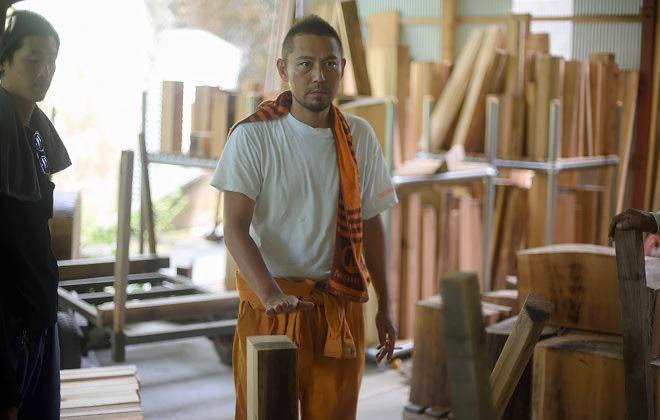
「増えずぎて切らなければならない杉の木で、みんなが豊かになる仕組みを作ろう」と廣瀬さんは言う。
廣瀬さんとお会いしたのも、金泉製材所の林業体験がきっかけだ。
金泉製材所の一角に、廣瀬さんが発案した、商品のための木材が、アイデアと共に、たくさん寝かされていた。
「SHIZQ」と名づけられた器もそのひとつ。
未来の子供たちに少しでも多くの「しずく」を残すために、自分たちのできることから活動を始めたそうだ。
SHIZQの商品は、建材ではやらない特別な製材方法で、丸太から商品専用に考えてスギの木を挽いていくそう。
寝かされていた木の中には、ランプシェード(ランプの笠の部分)になるものも、一緒に置かれていた。
独特の木取りの仕方で、一つの器に対して、色合いも2種類入れるというこだわりも、SHIZQならではである。しかも特殊なセラミックコーティングにより耐熱使用。この横木目の柄が、とても美しいものに感じた。
僕たちも、最初の一か月間滞在していたスキーランドホテル生活卒業の時に、オーナー地中夫妻に鶴ぐい呑みを、現住居の殿宮邸オーナー森下さんには、鶴コップをそれぞれプレゼントした。
そんなSHIZQは、神山町産の杉を材料としている。
経済的影響により、国産木材の需要が減るなどで、戦後盛んだった林業が衰退して、人は木を伐らなくなった。
針葉樹(スギ、ヒノキなど)は葉を落とさない。そのため、地表に光が届かなくなり下草も生えず山肌が痩せ、保水力が弱くなる。
それらを解決するには、まずは間伐、つまり「木を伐る」ことがとても重要なのだ。
「SHIZQはこうした中山間地域の課題を啓発するのが、一番のミッションだ。」と廣瀬さんは言う。
周りの意識を変えることがデザイナーである廣瀬さんにとって、できる一番の役割と考えているのだそう。実際ご自身も山に入り、職人さんと一緒に木を伐るところから身をもって携わっている。
僕が前職でも使っていた建築材として商品になるものは、木を伐った中の2、3割程度にしかならないという話も聞いて驚いた。
自分たちの活動を続けるための原資をどうやって稼ぐ?これらが「SHIZQ」ブランドの生まれたわけだそう。
「自然を守りながら、杉の新しい価値をいかにみいだせるか?」
SHIZQという商品の背景を知り、何気なく過ごしてきた自分の暮らしにも「あるものを使い、新しい価値を生み出す」感覚を取り入れていきたいと感じた。
是非一度、SHIZQの商品を手に取ってもらいたい。
木から人が集う場所を作る人
「楽しいから生まれる場所」
Angel‘s Dust 宗本 恵一(むねもと けいいち)さん

いつもニコニコと笑顔で迎えてくれる宗本さん。
いつも楽しいと思うことを探していて一緒にいるとこちらまでワクワクする。
僕が神山で生活をしていて感じるのは、移住してきた人たちは、非常に多種多様な人たちばかり。そして地元の人たちは、本当に寛容な方ばかりだと思う。
しかし、そんな移住者や、神山町内、町外の人が交わる場所がまだまだ少ないのも事実だ。
そんな中、上分地区に新たな集いの場所が出来た。ロンドンの折り畳み自転車ブロンプトンがずらりと並ぶ、もともと製材所を営んでいた大門さん一家が経営するカフェブロンプトンデポである。
僕が、カフェブロンプトンデポに出会ったきっかけは、町内にある寄居商店街のカフェオニヴァに行ったとき、オーナー郁子さんに「明日、自転車で早朝走りませんか?」と誘われたのがきっかけだった。
日の出を見るなんて時間にほとんど起きない僕たちものさす塾生が、早朝5時半にお店に集合し、30㎞という距離をブロンプトン自転車で走った。
さすがに余裕だったとは言えないが、山あり谷ありな道を走り切り、筋肉痛にもならず、気持ちよく完走できた。
この時、自転車で案内してくれたのが宗本さん。
宗本さんは、ログハウスを建てたり、家具や、小物のプロダクツを作ったりと様々なことに木工のクラフトを通して挑戦を楽しみ続けている人である。常に好奇心とアイディアを組み合わせ、人を楽しく巻き込んでいく力のある人だ。
その彼もメンバーであるチームブロンプトンは、自転車で神山町内の名所を回り、神山の自然を楽しんでもらおうと、ほぼボランティア同然で町を案内し、神山町の地域貢献のために動いている寛容な人たちだ。
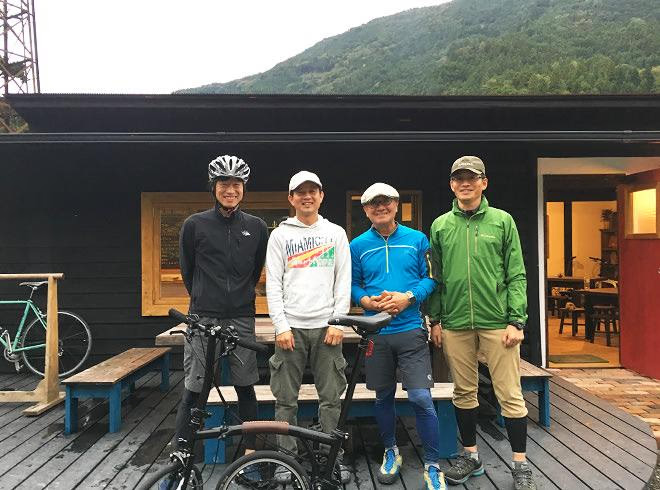
チームブロンプトンのメンバー:左から、寄居商店街クリーニング屋の鍛さん、ブロンプトンオーナー大門さん、クラフトアイディアマン宗本さん、役場観光課高橋さん。4人のアイディアと行動が、自転車を通してお店作りのカタチになっている。
神山町内でも少し奥まった場所に位置しているが、このカフェができたことで、徳島市内など遠方からの利用者も増え、サイクリストや地域の人たちの交流の場としても機能している。目の前に流れる川は上流ということもあり、とてもきれいだ。

サイクリングコースの要所要所に、手作りの立て看板がある。
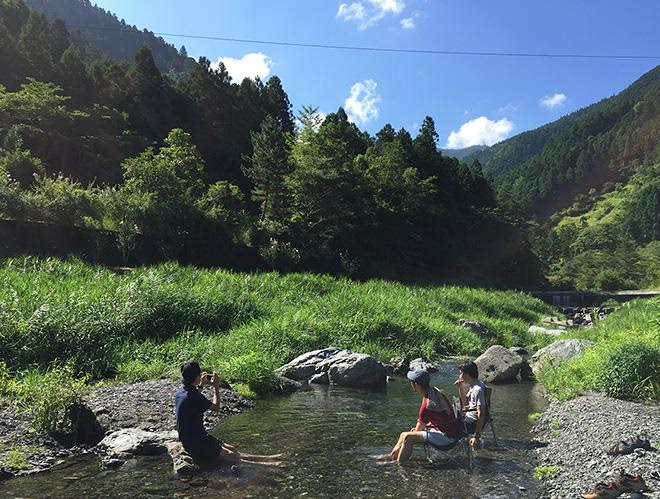
夏の間は、カフェの前にある川の中に、アウトドアチェアをいれてしまい、足だけ浸かりながらゆっくりとできる。
カフェブロンプトンの正面に位置する大門製材所裏にも、宗本さんのアイディアで「森のオフィスをつくろう」と、木が突き抜けたようなデザインのウッドデッキスペースが広がっている。
週末にウッドデッキの足場を組み立てていたカフェオーナー大門さんに「手伝いましょうか?」と声をかけたことが、この後、この場に深く関わるきっかけになった。
「じゃあ、明日から本格的に作っていくけん、手伝ってもらおうか。」
次の日、自前の工具類を一式持っていってウッドデッキ作りを一緒にやっていった。
作っているうちに次から次へと人が集まり、わずか2日半で完成に至ったのだ。
最初はウッドデッキ製作を手伝っていた2人だったのが、最終的はボランティアで人が集まり、20人以上の人が一緒に作っていた。

映画鑑賞会をした時の様子。縦×横8mくらいの大きさで、もともと生えていたクヌギの木をあえて残した。wifiもつながるように調整中で、今後いろいろなことが起こりそうだ。
「いろんな道具が誰でも自由に使えるスペースとして機能させたい。新しく作るものがあるとワクワクするやろ。」と話す宗本さん。ゆくゆくはこの近くにも、神山の杉の木を使って、大門製材所を改造する計画も着々と進行中。木工細工やクラフトが、自由な環境でできるようにという夢を語ってくれた。
それを、移住者や若い人たちとできることを願って、今を精一杯楽しみながら、コツコツと人の輪を温めている。
僕にとってこの場所は、新しいことが始まる予感とエネルギーに満ち溢れている。
木を愛する人たち
僕たちが普段生活する中では見えてこない、モノの製作背景やそこに携わり交わる人たちが生み出すコトを、木を想う人たちを通して体験ができた。
神山の余りある杉の木を切る人、木から商品を生み出す人、木から人が集う場所を作る人がいる。それぞれの人たちから一貫して感じられるのは、人間関係も、そこで営むモノゴトも、自然の力に抗うことなく、多様な価値観を認め、カタチにしようとしていることだ。お金という価値だけでなく、それぞれのもっている価値を交換し、自然につながって新たな価値を見出そうとしている。
僕自身も神山ものさす塾で、もう一度自分自身の価値観を見つめなおすため、この土地を訪れた。木に携わる人たちの想いを知って、自分も何か生み出していきたい。たとえば、いろいろな人たちの助けを借りながら神山の木を使って、自分が暮らすログハウスを作ってみたいと思い始めている。
木を通して、自分なりの暮らし方を考えること、本来の自分に戻り、受け入れて行くことが、この神山でできるような気がしている。


